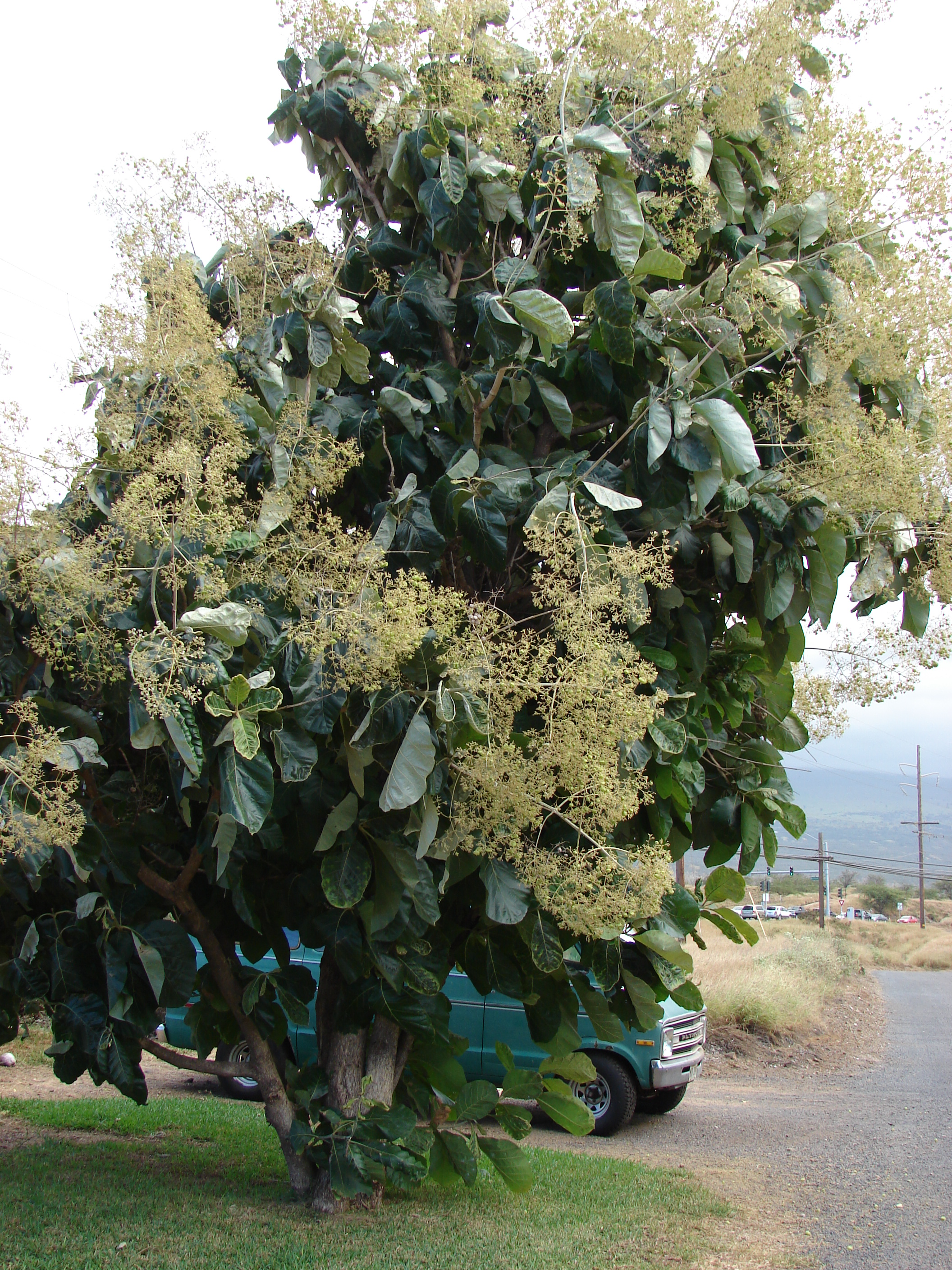Teak (Tectona grandis)
- Family: Lamiaceae
- Local Names: Bengali (Segun,saigun), Burmese (kyun), English (teak wood,Indian oak,teak tree), Filipino (dalanang,djati), French (teck), German (tiek,Teak(holz)baum), Gujarati (sagach,saga), Hindi (saigun,sagwan,sagun), Indonesian (kulidawa,deleg,jati)
Description
1. Tectona grandis is a large, deciduous tree reaching over 30 m in height in favourable conditions. Crown open with many small branches; the bole is often buttressed and may be fluted, up to 15 m long below the 1st branches, up to 1 m dbh. Bark is brown, distinctly fibrous with shallow, longitudinal fissures. The root system is superficial, often no deeper than 50 cm, but roots may extend laterally up to 15 m from the stem.
2. The very large, 4-sided leaves are shed for 3-4 months during the later half of the dry season, leaving the branchlets bare. Shiny above, hairy below, vein network clear, about 30 x 20 cm but young leaves up to 1 m long.
3. Flowers small, about 8 mm across, mauve to white and arranged in large, flowering heads, about 45 cm long; found on the topmost branches in the unshaded part of the crown.
4. Fruit is a drupe with 4 chambers; round, hard and woody, enclosed in an inflated, bladder-like covering; pale green at first, then brown at maturity. Each fruit may contain 0 to 4 seeds. There are 1 000-3500 fruits/kg.
Ecology
1. Tectona grandis will survive and grow under a wide range of climatic and edaphic conditions. For example, in northern Togo it grows in a region with an annual rainfall of nearly 600 mm and in Bangladesh a region with close to 4 000 mm. It grows best in a warm, moist, tropical climate with a significant difference between dry and wet seasons. It is a pioneer species, but with a long life span. In contrast to other pioneer species, T. grandis is able to persist and dominate and to naturally regenerate towards the climax phase of succession in most parts of its natural range.
2. It occurs naturally in various types of tropical deciduous forests. In seasonal climates, Tectona grandis is deciduous, while trees grown in non-seasonal climates are semi-deciduous. It is often a dominant member of a mixed deciduous forest, where its main associates are Xylia spp., Afzelia xylocarpa, Terminalia spp. and Lagerstroemia spp. The forest floor is often covered with bamboo. Tectona grandis generally occurs scattered but can form almost pure stands under favourable conditions. Young plants show a remarkable capability to recover after fire.
Native range
India, Indonesia, Laos, Myanmar, Thailand
Tree Management
Timber
A rare combination of superior physical and mechanical properties makes T. grandis a paragon of timber, and there is no likelihood of it being eclipsed by any other. The wood is a medium weight timber that is rather soft and has a characteristic appearance. The heartwood is often dull yellowish when freshly cut but turns golden brown or sometimes dark greyish-brown after exposure, often streaked grey or black. The sapwood is yellowish-white or pale yellowish-brown and up to 50 mm thick. Grain is straight, wavy or slightly interlocked, with rather coarse and uneven texture. Density of the wood is (min. 480) 610-750 (max. 850) kg/m³ at 12% mc. The wood is oily to the touch and when freshly cut has a smell reminiscent of leather. Being classified as very resistant to teredo activity, the wood is excellent timber for bridge building and other construction in contact with water such as docks, quays, piers and floodgates in fresh water. In house building, teakwood is particularly suitable for interior and exterior joinery (windows, solid panel doors and framing) and is used for floors exposed to light to moderate pedestrian traffic. It is also used quite extensively for garden furniture. Other uses are for building poles, transmission line poles, fence posts, wallboards, beams, woodwork, boxes, musical instruments, toys, railway sleepers and railcar construction. It is brittle and therefore less suitable for articles requiring high resilience, such as tool handles and sporting goods. Its high resistance to a wide variety of chemicals makes it ideal for laboratory and kitchen tables as well as for scrubbing towers, vats, pipes and fume ducts in industrial chemical plants. The wood grains are figured well, producing an attractive veneer, which is extensively used in the manufacture of furniture and interior fittings. Teakwood is suitable for the manufacture of decorative plywood. Larger logs are utilized for beams and sleepers, smaller ones for scantlings and battens, and thinner top ends and poles are used as round posts. Thinnings are also used for timber. The wood is very durable, difficult to preserve, saws fairly and seasons easily. For the export market, teakwood is recommended for ship decking and other constructional work in boat building. T. grandis is economically one of the most important timber tree species of Indonesia.
Shade or Shelter
Medicine
In traditional medicine, a wood powder paste has been used against bilious headaches and swellings and internally against dermatitis or as a vermifuge. The charred wood soaked in poppy juice and made into a paste has been used to relieve the swelling of the eyelids. The bark has been used as an astringent and the wood as a hair tonic.
Gum or Resin


